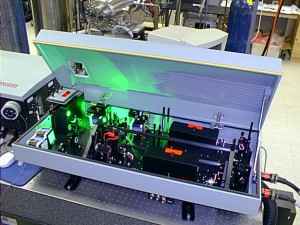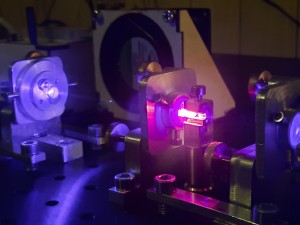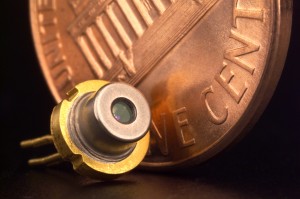Lasers have revolutionized many fields, from medicine to manufacturing, and their energy derives from the properties of their laser materials. In this article, we mainly introduce the three mainstream lasers, namely; Nd:YAG lasers ; ruby lasers; For semiconductor lasers(Laser diode), we will explore the advantages and scope of application of various lasers from different perspectives.
.Basic Working Logic:
. Nd:YAG Lasers:
Nd:YAG lasers work by excitation of neodymium ions embedded in the crystal structure of YAG. When these ions are stimulated by a specific wavelength of light, they emit photons, producing a laser beam. This laser process utilizes Neodymium's unique energy level configuration for efficient energy transfer and high output power.
. Ruby lasers:
Ruby lasers are the pioneers of solid-state laser technology. The laser emission process involves the excitation of chromium ions within the ruby crystal. The stimulated ions fall back to a lower energy level, emitting a laser in the process. The deep red emission wavelength of ruby lasers gives them their distinctive red color.
.Laser Diode:
In red diode lasers, the laser action occurs in the p-n junction of the diode. When an electric current passes through this node, a condition known as particle number reversal occurs. The excited electrons descend to a lower energy level and emit a red laser.
.Output wavelength and characteristics:
. Nd:YAG lasers These lasers can produce high power output in either continuous wave or pulse mode. The wavelength of 1064nm they produce is located in the infrared region, but the doubling can produce 532nm of green light.
. Ruby lasers emit pulsed lasers with a wavelength of 694.3nm. They typically have a lower output power than Nd:YAG lasers, but are known for their high peak power during short pulses.
. Red semiconductor lasers or diode lasers produce continuous-wave lasers in the red wavelength range, typically around 635-700nm. They are known for their high efficiency and compact size.
.Applications:
As we further explore the applications of Nd:YAG, ruby, and red semiconductor lasers, the integration of these technologies across various fields becomes increasingly apparent.
1. In laser engraving, Nd:YAG lasers are favored for their high power output and operational flexibility. They can provide continuous or pulsed outputs, making them suitable for a wide range of engraving tasks. These lasers can be used to engrave intricate details on a variety of materials, including metals, ceramics, and plastics, making them versatile. Nd:YAG lasers can also be fine-tuned to control the depth of engraving, ensuring high-quality results even on delicate materials. Nd:YAG lasers are also used in laser pointers due to their high power and infrared output. When the frequency is doubled, the Nd:YAG laser produces green light, which is more visible to the human eye than red light. This makes green laser pointers, powered by Nd:YAG lasers, popular in situations where visibility is critical. Laser technology has had a significant impact on medical treatment, with Nd:YAG, ruby, and red diode lasers all playing a role. Nd:YAG lasers are used in a variety of treatments, including laser eye surgery, dental surgery, and even cancer treatment. These lasers can deliver high-energy light to precise locations, making them ideal for surgeries and other medical procedures where precision is critical.
2. Ruby lasers, while not as widely used for engraving as Nd:YAG lasers, still have a place in some niche applications. For example, ruby lasers can be used for engraving and cutting gemstones because they have a high peak power output. They provide short, powerful pulses of light that can precisely cut or engrave gemstones, creating intricate designs without unnecessary damage. Ruby lasers have visible red light and have been used in dermatology. They are commonly used to treat skin conditions and remove tattoos. The high peak power of the ruby laser can target tattoo pigments or damaged skin cells without affecting the surrounding skin, making these treatments safe and effective.
3. Red diode lasers bring a completely different set of advantages to the engraving industry. Due to their compact size and high efficiency, these lasers are often used in portable engraving equipment. Ideal for small businesses and hobbyists, these compact engravers can accurately engrave on a variety of materials such as wood, leather, and certain metals. Red diode lasers are widely used in low-intensity laser therapy (LLLT) and photodynamic therapy. In LLLT, the red light emitted by these lasers helps promote wound healing and reduce inflammation. In photodynamic therapy, these lasers activate photosensitizers to destroy cancer cells. With their high efficiency and long service life, red semiconductor lasers have become an essential part of modern medical technology.
In conclusion, Nd:YAG, ruby, and red semiconductor lasers have made significant contributions to various fields. Their unique features and capabilities facilitate advancements in industrial, medical, and consumer applications. As laser technology continues to evolve, we can expect these lasers to play an even greater role in shaping our future.
.Comparison of advantages :
When comparing the benefits of Nd:YAG, ruby, and red diode lasers, it's clear that each laser type offers a unique set of benefits that make it suitable for a variety of applications.
Nd:YAG lasers have powerful and flexible properties, making them one of the most versatile lasers. They are capable of producing high output power in both CW and pulse modes, giving users the option to choose the best mode for their specific application. In addition, the infrared output of Nd:YAG lasers can be absorbed by a wide range of materials. This, combined with the high power output, makes Nd:YAG lasers the first choice for many industrial applications such as cutting, welding, and drilling.
Ruby lasers have the superior ability to produce high peak power in a short period of time. This unique feature makes them particularly suitable for applications that require large amounts of energy in a short period of time. For example, in laser-induced breakdown spectroscopy, the high peak power of a ruby laser is used to ionize a sample, enabling spectroscopic analysis of its atomic composition. In addition, the visible red output of the ruby laser provides additional benefits for alignment and aiming purposes in a variety of applications, enhancing user control and precision.
Red diode lasers are distinguished by their compact size, high efficiency, and long service life. These lasers are small in size and can be integrated into compact devices such as laser pointers, DVD players, and barcode scanners. The high efficiency of red diode lasers means that they can convert a high proportion of electrical energy into light, making them energy-efficient and cost-effective in the long run. In addition, its long service life reduces the need for frequent replacements, further increasing cost-effectiveness.
In consumer electronics, the compact size and efficiency of red semiconductor lasers make them an essential component of many devices. They are used in CD players, DVD players, and Blu-ray players to read data from discs. In communication technology, these lasers play a vital role in transmitting information in fiber optic cables. Red diode lasers are capable of producing a specific, stable wavelength of light, enabling the transmission of large amounts of data over long distances.
As is clear from the above discussion, each laser type (Nd:YAG, Ruby, and Red Semiconductor) has its own set of benefits that make it ideal for a variety of applications. Whether in industrial manufacturing, scientific research, consumer electronics, or medical treatments, these lasers continue to play an integral role in driving advancements in various fields.
Nd:YAG, ruby and red diode lasers each offer unique advantages. Their respective operating principles, output characteristics, applications, and advantages highlight the power and versatility of red laser crystals. As technology advances, we can expect these lasers to play a more critical role in various fields.
Post time: Dec-27-2023







